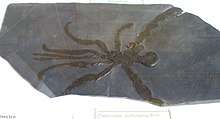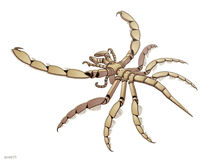Palaeoisopus
Palaeoisopus is a monotypic genus of fossil pycnogonid (sea spider), known only by one species, Palaeoisopus problematicus, discovered from the Lower Devonian Hunsrück Slate of Germany.[1] It have several characters unusual for a pycnogonid, such as swimming legs with alternating size, medially-arranged eyes, and most significantly, a long, segmented abdomen, which were highly reduced in modern counterparts.[1]
| Palaeoisopus | |
|---|---|
 | |
| Fossil | |
 | |
| Reconstruction | |
| Scientific classification | |
| Kingdom: | |
| Phylum: | |
| Subphylum: | |
| Class: | |
| Order: | †Palaeoisopoda |
| Family: | †Palaeoisopodidae |
| Genus: | †Palaeoisopus Broili, 1928 |
| Species | |
| |
Morphology
Palaeoisopus is a large sea spider, with a body length (excluding proboscis and chelifores) of at least 12.5 cm and leg spans of about 32 cm, comparable to those of a modern Colossendeis (giant sea spider).[1] The margins of each of its body parts were covered by tubercles, the cephalon (head section that bore eyes, proboscis, chelifores, palps, ovigers and 1st leg pair) and 3 trunk somites (section that bore the remaining leg pairs) are well-defined by ring-like segmentation. The abdomen apparently compose of 4 abdominal somites and a styliform telson,[2] but based on the medial position of anus (which, in telson-bearing chelicerates, always located at the ventral boundary of abdomen and telson), the latter was also suggest to be a fusion of 5th abdominal somite and the original telson.[1]
.jpg) Fossil of Palaeoisopus, showing the long, fully-extended 1st leg pair.
Fossil of Palaeoisopus, showing the long, fully-extended 1st leg pair.- Ventral fossil, showing full set of appendages.
- Fossil compose of 3 individuals, showing dorsal morphology.
Medial to the anterodorsal margin of cephalon was an eye-bearing ocular tubercle. Unlike the paired 4-eyed arrangement of most pycnogonids, it compose of a pair of large eyes and 2 smaller eyes that arranged anteroposteriorly in a midline.[1] The anteriormost appendages were a pair of robust, pincer-like chelifores, which compose of 5 podomeres (3 for scape and 2 for pincer) instead of 3 or 4 (1 or 2 for scape and 2 for pincer) like those of the other pycnogonids.[3] Below the chelifores was a cylinderal proboscis that always tucked underneath the cephalon, making it almost invisible in dorsal view.[1] The palps and ovigers have similar morphology, the former terminated with a subchelate structures and the latter was apparently absent in some specimens, which may represent sexual dimorphism as seen in some modern pycnogonid taxa[1] such as Pycnogonidae and Phoxichilidiidae (female lacking ovigers).[4][5] Each of the leg base was surrounded by flexible, ring-like structure.[1] Among the 4 leg pairs the first one is significantly elongated, and its detail morphology slightly differ from the posterior counterparts as well (e.g. shorter basal segments, different setae arrangement, 4 flatten distal podomeres instead of 5).[1]
Paleoecology
The large eyes, robust chelifores and oar-like legs suggest that Paleoisopus was a nektonic (swimming) visual predators, with associated stalked crinoid (sea lily) as a possible prey item.[1]
Phylogeny
While some analysis placing Palaeoisopus within a derived position,[6] most studies suggest that Paleosiopus is a basal sea spider,[1][7][8] as the well-developed abdomen most likely represent a plesiomorphic condition of total-group Pycnogonida.[1][9]
References
- Bergström, Jan; Stürmer, Wilhelm; Winter, Gerhard (1980-06-01). "Palaeoisopus, Palaeopantopus and Palaeothea, pycnogonid arthropods from the Lower Devonian Hunsrück Slate, West Germany". Paläontologische Zeitschrift. 54: 7–54.
- Dunlop, Jason A.; Lamsdell, James C. "Segmentation and tagmosis in Chelicerata". Arthropod Structure & Development. 46 (3): 395. ISSN 1467-8039.
- Brenneis, Georg; Arango, Claudia P. (December 2019). "First description of epimorphic development in Antarctic Pallenopsidae (Arthropoda, Pycnogonida) with insights into the evolution of the four-articled sea spider cheliphore". Zoological Letters. 5 (1): 4. doi:10.1186/s40851-018-0118-7. ISSN 2056-306X. PMC 6330760. PMID 30656062.
- Bain, Bonnie A.; Govedich, Fredric R. (December 2004). "Courtship and mating behavior in the Pycnogonida (Chelicerata: Class Pycnogonida): a summary". Invertebrate Reproduction & Development. 46 (1): 63–79. doi:10.1080/07924259.2004.9652607. ISSN 0792-4259.
- Ballesteros, Jesús A.; Setton, Emily V. W.; López, Carlos E. Santibáñez; Arango, Claudia P.; Brenneis, Georg; Brix, Saskia; Cano-Sánchez, Esperanza; Dandouch, Merai; Dilly, Geoffrey F.; Eleaume, Marc P.; Gainett, Guilherme (2020-02-02). "Phylogenomic resolution of sea spider diversification through integration of multiple data classes". bioRxiv: 2020.01.31.929612. doi:10.1101/2020.01.31.929612.
- Arango, Claudia P.; Wheeler, Ward C. (June 2007). "Phylogeny of the sea spiders (Arthropoda, Pycnogonida) based on direct optimization of six loci and morphology". Cladistics. 23 (3): 255–293. doi:10.1111/j.1096-0031.2007.00143.x. ISSN 0748-3007.
- Siveter, Derek J.; Sutton, Mark D.; Briggs, Derek E. G.; Siveter, David J. (October 2004). "A Silurian sea spider". Nature. 431 (7011): 978–980. doi:10.1038/nature02928. ISSN 1476-4687.
- Poschmann, Markus; Dunlop, Jason A. (2006). "A new sea spider (Arthropoda: Pycnogonida) with a flagelliform telson from the Lower Devonian Hunsrück Slate, Germany". Palaeontology. 49 (5): 983–989. doi:10.1111/j.1475-4983.2006.00583.x. ISSN 1475-4983.
- Kühl, Gabriele; Poschmann, Markus; Rust, Jes (May 2013). "A ten-legged sea spider (Arthropoda: Pycnogonida) from the Lower Devonian Hunsrück Slate (Germany)". Geological Magazine. 150 (3): 556–564. doi:10.1017/S0016756812001033. ISSN 0016-7568.